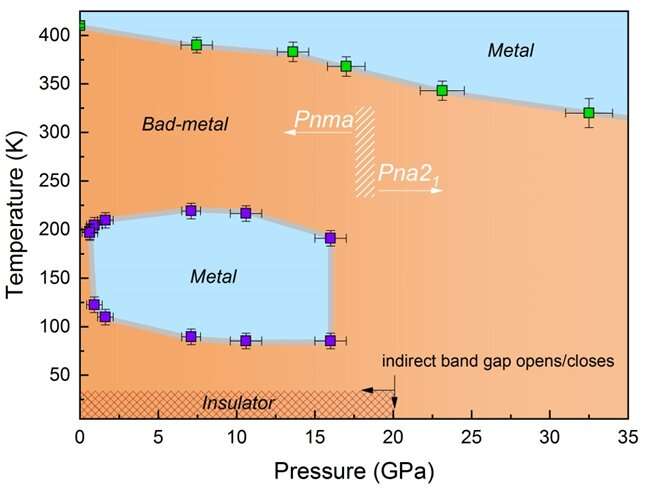Aberrant electronic and structural alterations in pressure-tuned perovskite

The perovskite NaOsO3 has a complicated but interesting temperature-dependent metal-insulator transition (MIT). A team led by Drs. Raimundas Sereika and Yang Ding from the Center for High Pressure Science and Technology Advanced Research (HPSTAR) showed that the insulating ground state in NaOsO3 can be preserved up to at least 35 GPa with a sluggish MIT reduction from 410 K to a near room temperature and possible transformation to a polar phase. The work has been published in npj Quantum Materials.
NaOsO3 perovskite undergoes a metal-insulator transition concomitant with the onset of an antiferromagnetic long-range ordering at a Neel temperature of about 410 K, which is accompanied by a magnetic ordering without any lattice distortion.
The team carried out a combined experimental and computational study to understand the effect of external pressure on perovskite NaOsO3. They found hidden hysteretic resistance properties with a transient metallic state near 200 K. Also three electronic character anomalies (at 1.7, 9.0, and 25.5 GPa), and a structural transition to the singular polar phase (at ~ 18 GPa) were discovered.
In terms of the MIT, the pressure-dependent electrical transport measurements indicate that the metallic state extends to the lower temperatures very slowly. The TMIT scales almost linearly upon pressure. At around 32 GPa, the MIT becomes much broader, but can still be identified. Importantly, up to this pressure, NaOsO3 preserves the insulating ground state.
In addition, the warming and cooling curves slightly deviate, forming a narrow thermal hysteresis loop below MIT. The hysteresis is progressively attenuated upon pressure but eventually disappears at about 18 GPa. "The observed hysteresis raises a question if MIT is really the second-order type that was initially assigned," Sereika said.
Further, when the pressure is increased, the Raman results show that NaOsO3 experiences a structural change. The Raman spectra in particular demonstrate the enhancement of the number of phonons and the pressure-induced-splitting of phonon mode above 18 GPa.
"Our pressure-dependent Raman measurements support the fact that the crystal symmetry does not change up to 16 GPa at room temperature and indicates that further pressure increase causes structural transformation to a different symmetry," Ding explained.
"At about 26 GPa, the continuous large-scale reduction in intensity is observed as the pressure increases. Finally, the Raman modes almost vanish at 35 GPa, indicating that sample is approaching a metallic state, that is the MIT," Ding added.
By combining theoretical modeling and experimental data all observed phenomena were explained in detail. A rich electronic and structural phase diagram of NaOsO3 shows the different types of transitions occurring in the system when pressure and temperature are applied: insulator-to-bad metal, bad-metal-to-metal, the anomalous metal island in the bad-metal region, and the subtle non-polar to polar structural transition.
At low temperature the system remains insulating up to a certain critical pressure (~20 GPa in DFT) and then transforms into a bad metal due to the closing of the indirect gap. In this pressure range the valence and conduction bands are still separated by a direct gap. This gap closes at very large pressure, indicating that the evolution of the electronic properties upon pressure share similarities with the temperature-induced band gap closing process.
"The magnetically itinerant Lifshitz-type mechanism with spin-orbit and spin-phonon interactions is responsible for these pressure-induced changes," Ding said. "Our findings provide another new playground for the emergence of new states in 5-D materials by using high-pressure methods."
More information: Raimundas Sereika et al, Aberrant electronic and structural alterations in pressure tuned perovskite NaOsO3, npj Quantum Materials (2020). DOI: 10.1038/s41535-020-00269-3
Provided by Center for High Pressure Science & Technology Advanced Research


















